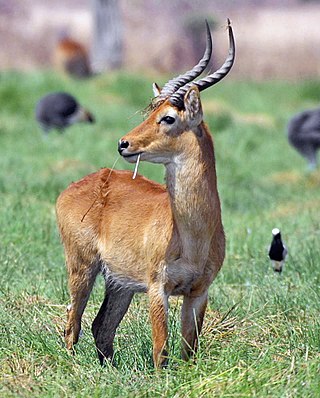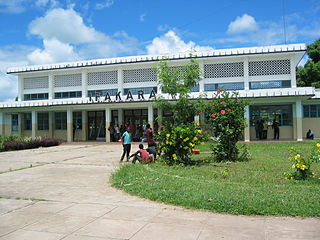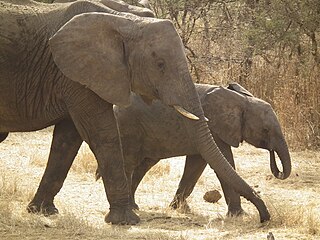Related Research Articles

East Africa, Eastern Africa, or East of Africa, is the eastern subregion of the African continent. In the United Nations Statistics Division scheme of geographic regions, 10-11-(16*) territories make up Eastern Africa:

The puku is a medium-sized antelope found in wet grasslands in southern Democratic Republic of Congo, Namibia, Tanzania, Zambia and more concentrated in the Okavango Delta in Botswana. Nearly one-third of all puku are found in protected areas, zoos, and national parks due to their diminishing habitat.

Dodoma Region is one of Tanzania's 31 administrative regions. The regional capital is the city of Dodoma. The region is located in central Tanzania, it is bordered by Singida Region to the west; Manyara Region to the north; Iringa Region to the south; and Morogoro Region to the east. Dodoma Region hosts the nation's capital city with where the legislative assembly or Bunge is based. Dodoma Region also hosts one of the largest University in Tanzania, University of Dodoma. The regiom is sole home of the Tanzanian wine industry, which is the second largest wine industry on the continent after South Africa. According to the 2012 national census, the region had a population of 2,492,989.

Lake Rukwa is an endorheic lake located the Rukwa Valley of Rukwa Region, Songwe Region and Katavi Region in southwestern Tanzania. The lake is the third largest inland body of water in the country.

Rukwa Region is one of Tanzania's 31 administrative regions with a postcode number 55000. The regional capital is the municipality of Sumbawanga. According to the 2012 national census, the region had a population of 1,004,539. For 2002–2012, the region's 3.2 percent average annual population growth rate was tied for the third highest in the country. It was also the twentieth most densely populated region with 44 people per square kilometer.

Ifakara is a small rural town in the Kilombero District, Morogoro Region, south central Tanzania. It is the headquarters of the Kilombero District administration and the main trading centre for Kilombero and Ulanga districts. The town is located near the Tanzania-Zambia Railway (TAZARA) line, at the edge of the Kilombero Valley, a vast swampland flooded by the mighty Kilombero River.
The Rombo language, or Kirombo, is a Bantu language of Tanzania spoken by the Chaga people, in the Chaga area of the Kilimanjaro region. Rombo forms a dialect continuum with other Chaga languages.

The Usambara Mountains of northeastern Tanzania in tropical East Africa, comprise the easternmost ranges of the Eastern Arc Mountains. The ranges of approximately 90 kilometres (56 mi) long and about half that wide, are situated in the Lushoto District of the Tanga Region. They were formed nearly two million years ago by faulting and uplifting, and are composed of Precambrian metamorphic rocks. They are split into two sub-ranges; the West Usambaras being higher than the East Usambaras, which are nearer the coast and receive more rainfall.
The Akiek are an ethnic and linguistic group in Tanzania and Kenya, living in the Arusha Region in northern Tanzania and in southern Kenya, with an estimated population of 3,700 people. The Akiek language is said to be a moribund language: only a few elderly speakers are left. The Akiek in Tanzania now speak Maasai, and those in Kenya speak kalenjin.
Mwanga, or Namwanga (Nyamwanga), is a Bantu language spoken by the Mwanga people in the Northern Province of Zambia and in Mbeya Region, Tanzania. The 2010 Zambian census found 140,000 speakers. The current number in Tanzania is unknown; Ethnologue cites a figure from 1987 of 87,000.
The Nyambo, or Ragwe, are a Bantu ethnic and linguistic group based in the Karagwe District of Kagera Region in far northwestern Tanzania. The Nyambo population is estimated to number 670,000. Their closest relatives are the Haya people.
The Ndamba are an ethnic and linguistic group based in south-central Tanzania whose population was 79,000 in 1987. They are found in everywhere in Tanzania especially south central, the Morogoro Region, northeast of Bena, southeast of Hehe, west of Pogolo and southwest of Mbunga.

The Ndali are a Bantu ethnolinguistic group native to Mbeya Region, Songwe Region, Tanzania and northern Malawi. In 1987 the Ndali population of Tanzania was estimated to number 150,000, and in 2003 the population in Malawi was estimated at 70,000, for a total for the group of about 220,000. Their language is related to many Bantu languages, for example Nyakyusa.
The Kahe are an ethnic and linguistic group based southeast of Moshi in Kilimanjaro Region Tanzania. The Kahe language, or Kikahe, is in the Chagga cluster of Bantu languages. Three dialects are recognized: Kimwangaria, Msengoni and Kichangareni. Kikahe is spoken by 9,130 people, and is one of the smaller language communities in Tanzania.

The Ha, also called or Abaha, are a Bantu ethnic group found in Kigoma Region in northwestern Tanzania bordering Lake Tanganyika. In 2001, the Ha population was estimated to number between 1 and 1.5 million, making them one of the largest ethnic groups in ethnically diverse Tanzania.
Kalenga is an administrative ward in the Iringa Rural district of the Iringa Region of Tanzania. In 2016 the Tanzania National Bureau of Statistics reported its population to be 7,286, up from 6,963 in 2012.
Hehe, also known by its native name Kihehe[kihehe], is a Bantu language that is spoken by the Hehe people of the Iringa region of Tanzania, lying south of the Great Ruaha River. It was reported to have "Ngoni" features, that is, words of a Zulu-like language introduced when conquered by a Nguni or Zulu-like people in the early 19th century. However, other "Ngoni" speeches seem to have lost most of these distinctive features over the past 150-odd years, the language more resembling those of the neighbouring peoples. In 1977 it was estimated that 190,000 people spoke Hehe. There has been some Bible translation. Hehe may be mutually intelligible with Bena.
Ngurimi (Ngoreme) is a Bantu language of Tanzania. Ngoreme is spoken in the Serengeti District of the Mara Region of north-west Tanzania by some 55,000 people. There are two main dialects of Ngoreme - a northern dialect and a southern dialect - which maintain mutual intelligibility.
Up to the second half of the 20th century, Tanzanian literature was primarily oral. Major oral literary forms include folktales, poems, riddles, proverbs, and songs. The majority of the oral literature in Tanzania that has been recorded is in Swahili, though each of the country's languages has its own oral tradition. The country's oral literature is currently declining because of social changes that make transmission of oral literature more difficult and because of the devaluation of oral literature that has accompanied Tanzania's development. Tanzania's written literary tradition has produced relatively few writers and works; Tanzania does not have a strong reading culture, and books are often expensive and hard to come by. Most Tanzanian literature is orally performed or written in Swahili, and a smaller number of works have been published in English. Major figures in Tanzanian modern literature include Shaaban Robert, Muhammed Said Abdulla, Aniceti Kitereza, Ebrahim Hussein, Abdulrazak Gurnah and Penina Muhando.

Swaga Swaga Game Reserve is a Tanzanian game reserve located in northwest Dodoma Region, that gives refuge to elephants and other vulnerable animals. It is located 50.6 miles from the city of Babati.
References
- ↑ Pogolo at Ethnologue (18th ed., 2015) (subscription required)
- ↑ Jouni Filip Maho, 2009. New Updated Guthrie List Online
- Green, M. (2003). Priests, Witches and Power: Popular Christianity after Mission in Southern Tanzania. Cambridge: Cambridge University Press.